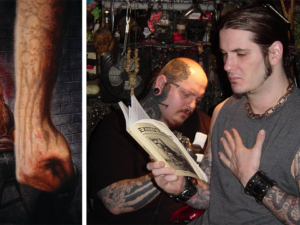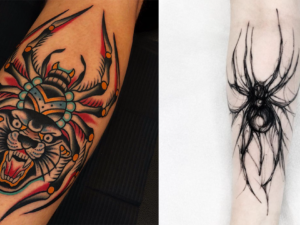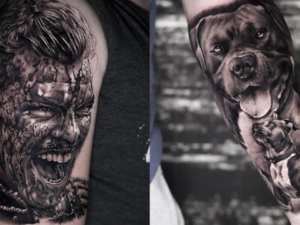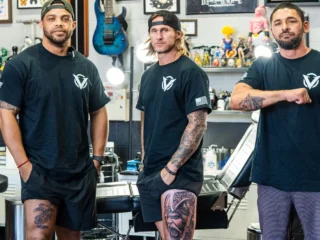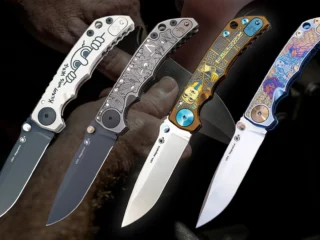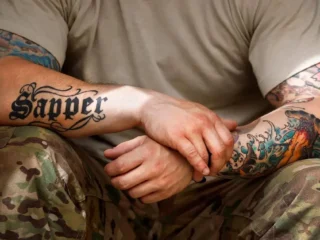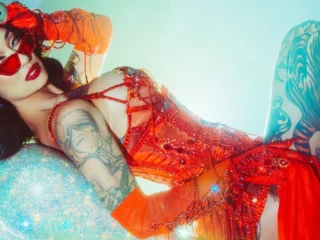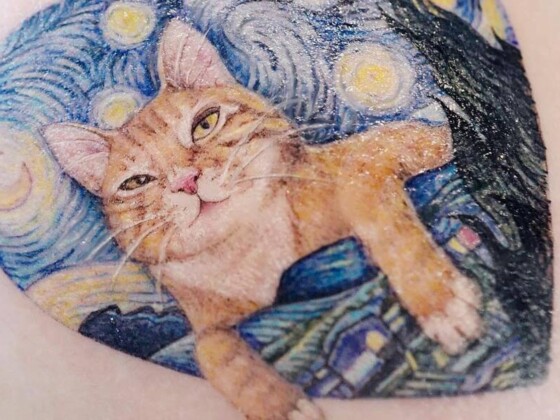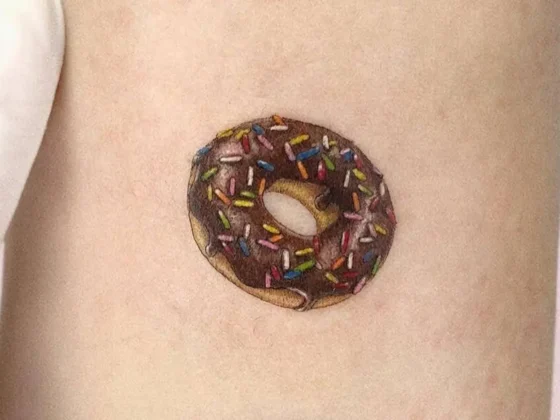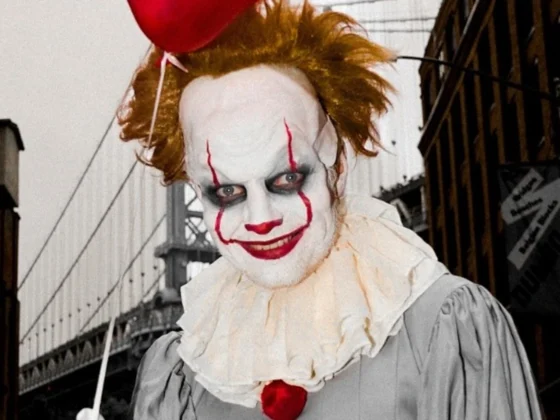Inked Mag
January 2nd, 2019
All You Need To Know About Black Light Tattoos, According to Tattoo Artists
INKED talks to tattoo artists around the globe, about the ins and outs of the UV tattoo trend that's flooding Instagram feeds.
There are many trends to make your skin glow, like makeup highlighter, the skin serums that fashion magazines swear by, or, of course, black light tattoos.
Having almost-invisible ink that glows under a blacklight is thought to be a superpower.
Until the “smart tattoo” is officially on the market—which will tell you when you need to reapply sunscreen or when your blood sugar is low—ultraviolet tattoos are the closest thing we have to “special, secret abilities.”

Black light tattoos are created using ultraviolet-reactive ink, and while UV tattoos are quasi-invisible in plain daylight, they shine under an ultraviolet black-light bulb. This is important to note, as many blacklight tattoo fans think their glow will simply show up in the dark.
Black light tattoos do not glow-in-the-dark in the same way your star stickers in your childhood bedroom glow.
UV tattoos are a cute “pop” in the tattoo world, and are gaining popularity for their creative twist on the traditional tattoo. Done properly, UV ink can make a tattoo look its best, making it as if the tattoo was made for blacklight ink. Blacklight tattoos can boost the concept of the tattoo, like glowing up the beam of a flying saucer; or add a little flair, like to the spots on a tiny teacup.

UV ink is thinner and harder to work with. This is why it is important to make sure the tattoo artist, and shop you are going to, are reputable and have worked with black light tattoos before.
INKED talks to blacklight tattoo artists about the ins and outs of the UV tattoo trend.
How does the process differ from a “regular” tattoo?
Quinton McCloud, tattoo artist at Karmic Tattoo in South Atlanta, had done his first black light tattoo with hesitance to “over glow.”
“Because it was my first time doing it, I just wanted to test it out by putting a little here and there,” McCloud said.
The tattoo, of a gecko wearing a party hat, is best highlighted with UV ink, in the “here and there” spots McCloud tested it on: on the fingernails, in the party hat, and in the confetti.

McCloud always wanted to try blacklight tattoos, but said during his apprenticeship, the mentor dismissed the credibility of the newly-budding practice.
“I asked him why I never really saw or heard of anyone getting them, and he told me that the only place you could get UV ink at the time was from sources that weren’t really trustworthy tattoo suppliers, like eBay and Amazon,” McCloud said.
A couple years later, McCloud stumbled upon Kurosumi Ink’s UV pigment line, Kuro Sumi Glow.
“They released green, red, pink, etc., so I ordered the green to give it a try.”

For McCloud’s second round, he tattooed a Xenomorph mouth mock of plastic vampire teeth. He used his liner needles to apply the ink.
“With the teeth, I used a shader on the whole thing and it got super irritated in the skin,” McCloud said. “This was weird because I run my machine pretty low, and it’s very rare that my tattoos get anywhere near as irritated as this was.”
Kayla Newell, tattoo artist at Secret Club Tattoo in Portand, Oregon, had fallen victim to the UV ink-supply from Amazon when she first started with black light.

“My first blacklight tattoo was self-administered and done using this terrible quality UV pink ink that I found on Amazon. It was some Skin Candy knock-off brand that I think I bought because it was the cheapest shit on there. It definitely shows,” Newell said.
“All of the pink ink has nearly faded but the strange thing is that it does still glow under a blacklight. But I would not recommend this route to anyone else.”
How do you tattoo differently with the different ink?
Australian tattoo artist, Tukoi Oya, started tattooing with UV ink with a “rave til the grave” attitude.
“The consistency of the brand I use is pretty thin and opaque, so when you’re doing solid patches of color you need to be really careful not to overwork the skin, because it feels like more of a grey wash than normal color to apply,” Oya said.

“When they are healed they also have a kind of pastel and watered-down look, so you can see the phosphorus reflect through it.”
Tukoi Oya only “rates the lighter colors,” like yellow, pink, orange and green, and notes, “the purples and blues do not reflect as bright with the UV light because they’re darker pigments.”
Oya uses Dr. Pickles, feeling that that is “the best stuff, especially for fine line tattoos.”
Ceora Ink’s Samantha Ceora, in LA, notes that the stencil can contaminate the “invisible effect” of a blacklight tattoo
“The tattoo is done with a plastic disposable tip to avoid any discoloration. I also remove the stencil almost completely to avoid any trace of the ink contaminating the tattoo. The machine has to be turned down low and a uv light must be used periodically throughout the process,” Ceora said.

“One last thing is I make sure to get the ink in 1-3 passes max, to ensure the skin’s safety from scarring. After all, the whole point is to create an invisible tattoo.”
While Newell says the process of tattooing with UV ink is more or less the same in every way to traditional tattooing, she says the only difference is the pigment itself.
“The neon inks I use are pretty thick, much like white ink, so you have to be careful that it doesn’t separate or mix with any other colors once it’s been laid in,” she said. “If it gets anything too dark even smeared into it, it can negatively affect its ability to glow.”

What types of pieces might work best as a UV tattoo?
Tukoi Oya said, “I feel like when you add some UV here and there it looks best. Don’t go overboard with it. I find it looks best just doing small dots or small sections of color though.”
Oya continued, “Because they’re lighter pigments it’s important to keep it really clean so you don’t stain the skin when it’s healing, like a white tattoo. But it’s the same as normal.”
Newell said, “Anything really bold looks good in neon, especially when it’s done right next to a dark color, so that it pops. That’s why I like doing the 3-D effect in black and pink or blue and red.”

How to best heal a black light tattoo? Does this differ from the aftercare process for a “normal” tattoo?
Ceora said, “Usually I will layer some ink on top of the tattoo after finishing, and use SecondSkin bandage to seal it for 4-24 hours so the skin holds the ink.”
“It is exactly the same in every way,” Newell said. “I use Waverly Colors made in Baltimore, Maryland. I also have a few custom colors that I was recently gifted, made by Northwest Pigments, that I’m very excited about.”

How long do UV tattoos last?
“I’ve seen them last years,” Ceora said. “Though, it’s kind of a gamble. Everyone’s skin is different. The aftercare instructions need to be taken seriously and gently. Anyone considering a UV tattoo should seek out an experienced artist with the ink.”
“And consider a wide range of unknown side effects,” she said.
Tukoi Oya said, “They last about 5 years and they’ll gradually start to fade, just like a normal tattoo would over time. But that said, I saw a UV tattoo I did about a year-and-a-half ago the other day, and it’s still looking hella fresh.”

Are there side effects to a black light tattoo?
While the U.S. Food and Drug Administration has not approved any UV ink, the FDA has not approved any type of tattoo ink for injection into the skin at all, so take this with a grain of salt.
According to the FDA, “many pigments used in tattoo inks are industrial-grade colors suitable for printers’ ink or automobile paint.”
However, there is a worry UV tattoos can be harmful in the long run.

“Phosphorus is a popular ingredient to achieve the glow-in-the-dark effect, and there are some concerns that in high doses it can be carcinogenic,” Arash Akhavan, a New York City-based dermatologist said.
“I have only seen one out of 25 people have a bad reaction. They had some scarring and irritation, and loss of glow,” Ceora said. “Although I believe that was due to my amateur status at the time, and the brand of ink. Plus the person had extensive allergies to random things.”

Tukoi Oya uses Firefly ink and buys it from Protat, which is the biggest tattoo supplier in Australia. Oya said, “Its not FDA approved, but all of the UV tattoos I’ve done have healed up really nicely. There is phosphorus in so many things though, like washing powder, paper, and even some foods like potatoes. Literally anything that glows with a black light.”
She added, “So I feel for the nerds that say it’s cancer, you’re putting it your body anyway, ya damn fool.”

So, why UV tattoos?
“When I first started tattooing I really wanted to make stuff that looked like my paintings; abstract, geometric and wild colors. I had bought this ink at the local supply shop that was the most vivid, brightly colored neon pink I had ever seen and I already knew it would glow under blacklight just from the naturally fluorescent quality,” Newell said.
“Part of my mission was to get people to understand how it worked, the difference between my tattoos and the “glow in the dark” tattoos that gave people diseases, and the fact that there are non-harmful, blacklight-reactive tattoos.”
“Aside from that,” Newell added, “the act of seeing yourself glow under a blacklight is pretty magical, and that is hard to deny once you’ve seen it in real life.”

Editor's Picks
Paul Booth Illustrates Cover for Pantera Graphic Novel
The revered tattoo artist created a cover for a graphic novel celebrating the 30th anniversary of “Vulgar Display of Power”
Scary Spider Tattoos
Spiders are terrifying, yet for some reason people sure do love to get tattoos of them


